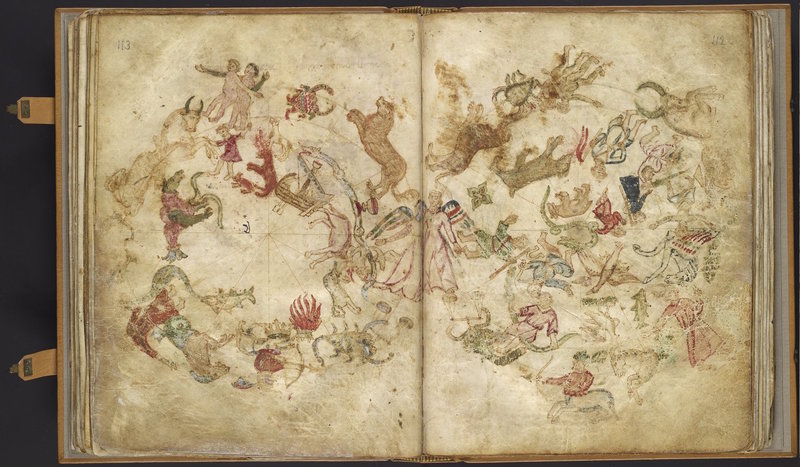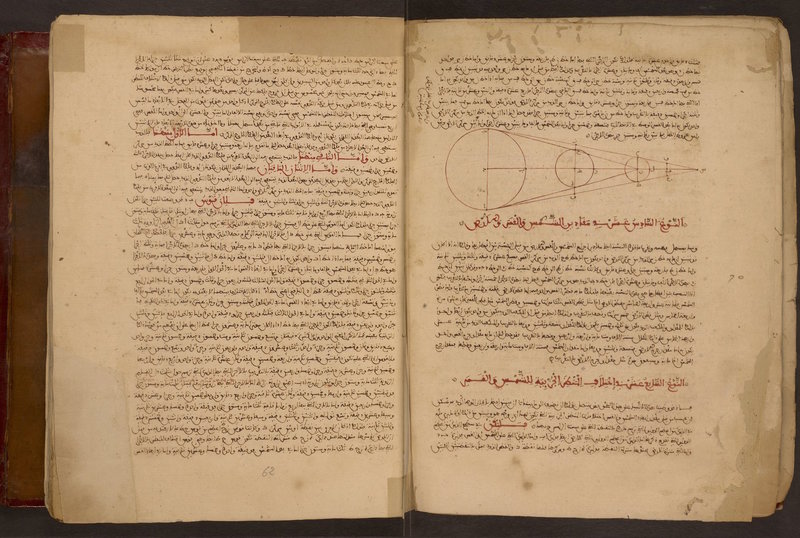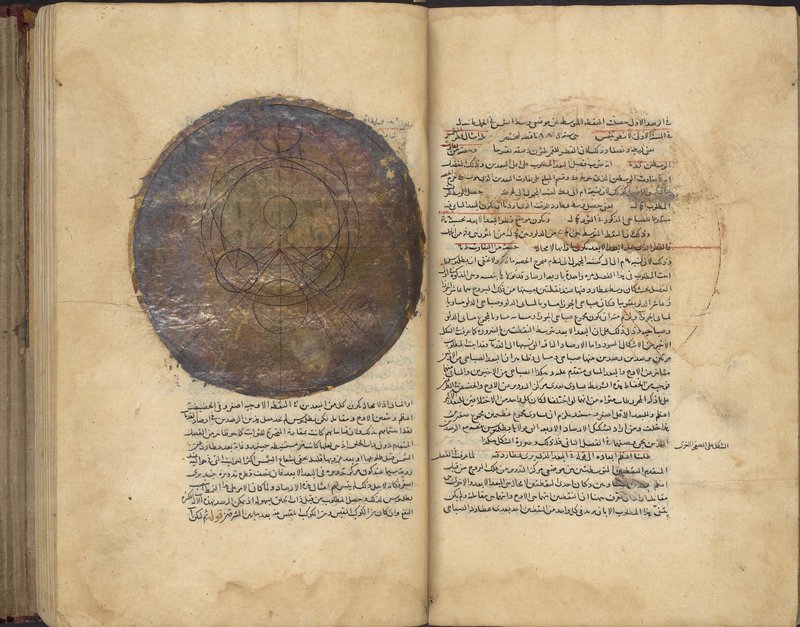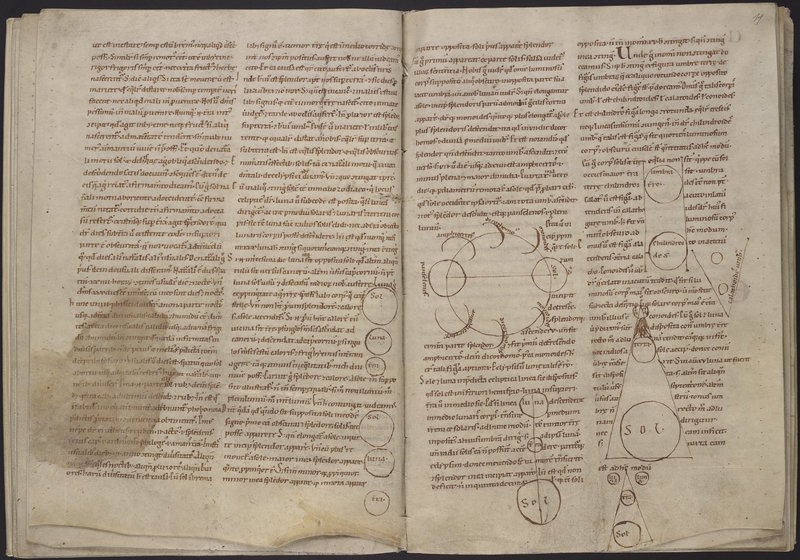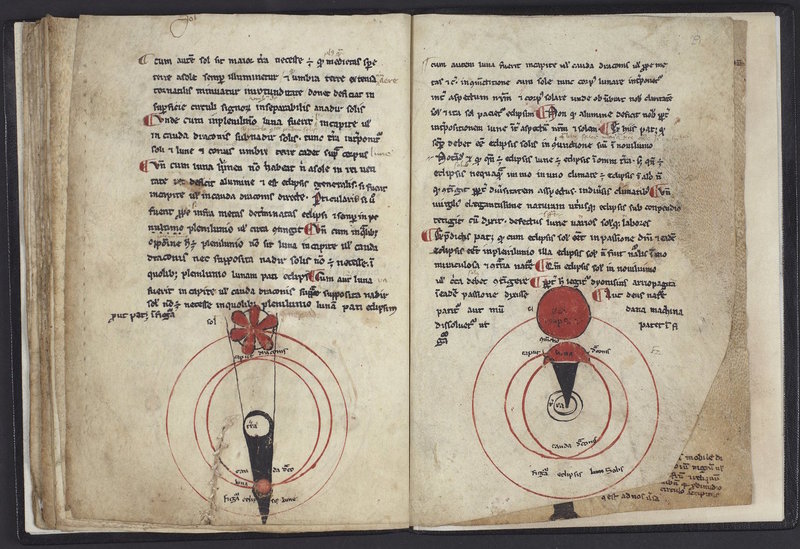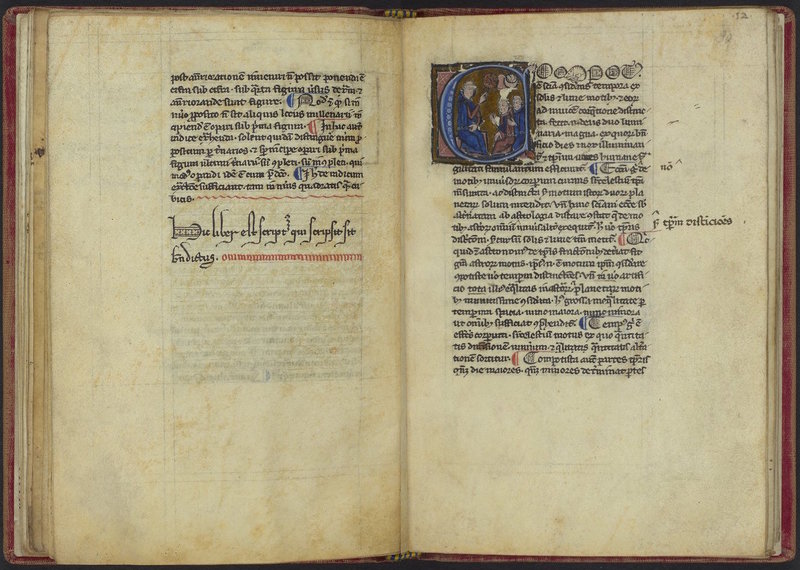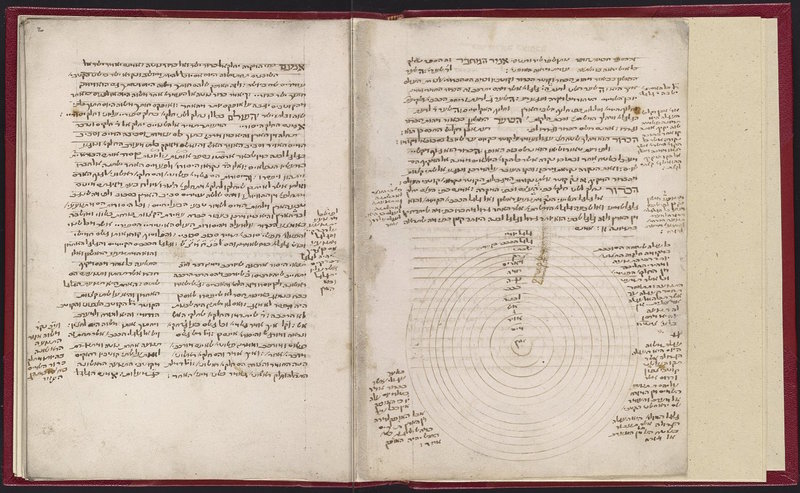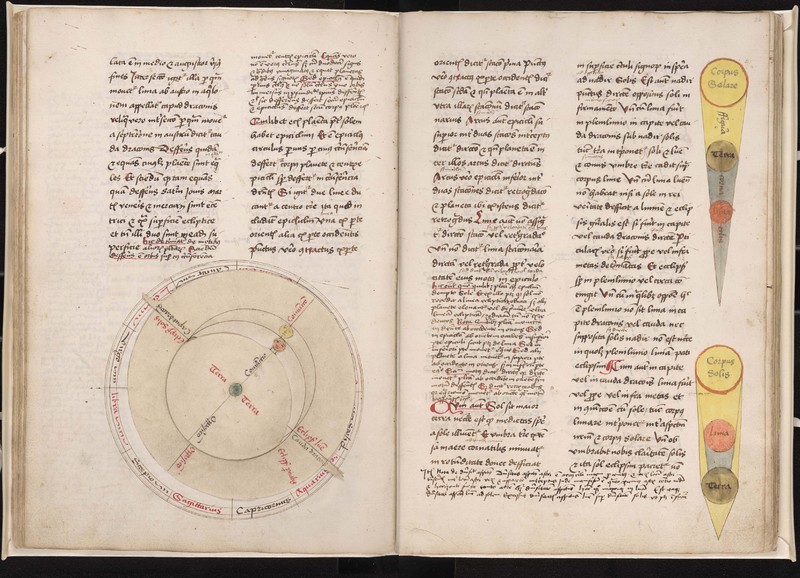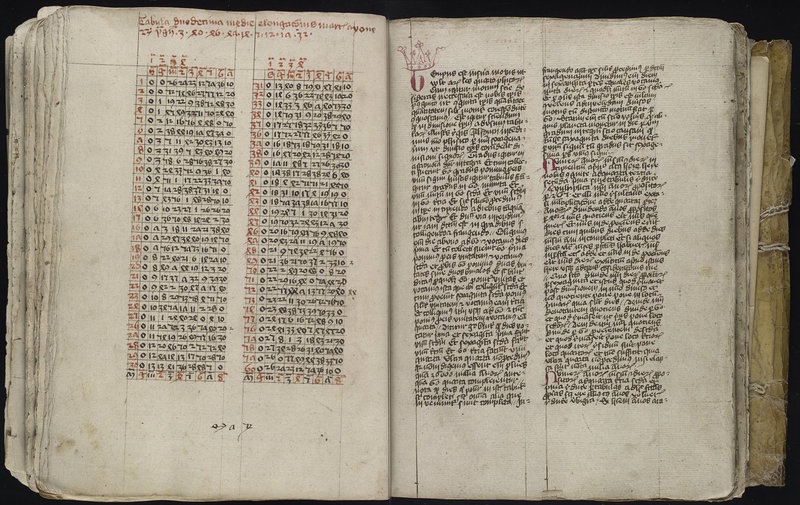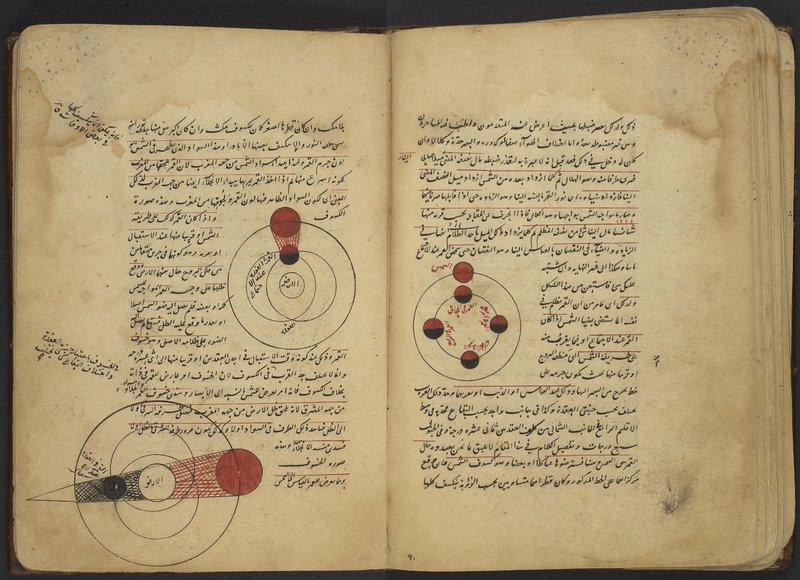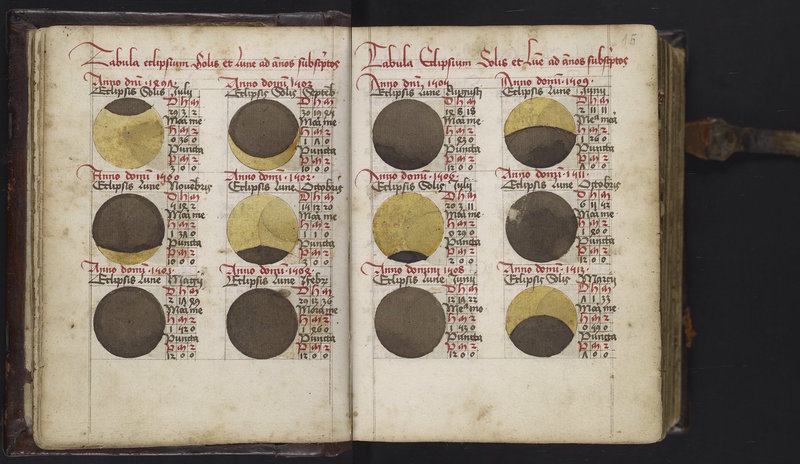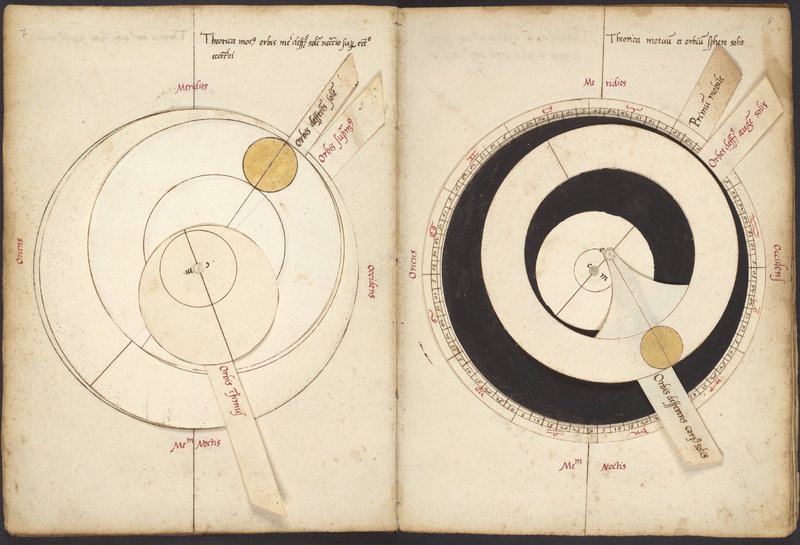The Scholarly Tradition
Astronomical Anthology. Catalonia, c. 1361. LJS 57, parchment, in Hebrew. Fols. 56v-57r.
Attesting to the central role of Jewish astronomers in medieval Spain, this volume begins with a treatise on the calendar compiled in 1361 by Jacob ben David ben Yom Tov for Pedro IV of Aragon. It also contains four astrological treatises by the twelfth-century philosopher Abraham Ibn Ezra, including discussions of Indian, Persian, and Babylonian astronomy, and a Hebrew translation of Ptolemy’s Almagest with this remarkable constellation map in ink and gouache. Later folios bear illuminated polychrome constellation images and intricately ornamented tables.
Fewer than thirty-five astronomical maps are known to survive from the Middle Ages, and this example, which shows the northern and southern celestial hemispheres and may have been copied from a globe, offers an especially rare glimpse into medieval Jewish celestial cartography. As Elly Dekker has observed (Illustrating the Phaenomena 458-61), the depictions of certain constellations (e.g. Aquila upside down and standing on Sagitta) and the presence of the Coma Berenices asterism above Leo resemble Islamic maps, while the human figures are drawn in Western European styles.
Claudius Ptolemy (c. 100-168 CE), Almagest. Andalusia, 1381. LJS 268, paper, in Arabic. Fols. 61v-62r.
With its rare Arabic copy of the Almagest, this manuscript is a clear example of the intercultural transmission of Ptolemy’s text. A colophon (fol. 185r) identifies the copyist as the Muslim astronomer Aḥmad ibn Aḥmad ibn Salāmah Sanhaja, who produced this manuscript for his Jewish teacher, Qursunna al-Isrāʼīlī, astronomer to Pedro IV of Aragon. It is dated according to Muslim, Jewish, and Christian calendars (783, 5141, and 1381).
Originally called Μαθηματικὴ Σύνταξις (Mathematical Syntaxis), the Almagest summarizes ancient astronomy in thirteen books, including planetary orbits, eclipses, and retrograde motion. The Almagest was translated into Arabic in the ninth century; indeed, its English name derives from the Arabic “al-majisṭī.” The most influential Latin translation was produced by Gerard of Cremona in 1175, while he was employed at the Toledo School of Translators.
Muhammad ibn Muhammad ibn al-Hasan al-Tūsī (aka Naṣīr al-Dīn al-Ṭūsī, 1201-1274), Tahrir al-Majisti, with commentary of Niẓām al-Dīn al-Nīsābūrī (d. 1328/9). Iran (?), AH 13 Dhu’l Qa‘da 813 (9 March 1411). LJS 392, paper, in Arabic. Fols. 156r-157v.
Naṣīr al-Dīn al-Ṭūsī was a prolific philosopher, mathematician, and theologian who is often considered to have created the discipline of trigonometry. His 150 compositions and translations include a work on the astrolabe, an Arabic version of Euclid’s Elements, and the Tadhkira fi ‘ilm al-ha’a (Memorandum of Astronomy), in which he corrected inconsistencies in the Ptolemaic system. In this thirteenth-century recension of the Almagest, he updates several of Ptolemy’s methods, substituting later trigonometric equations for Ptolemy’s chord calculations and simplifying the calculation of each planet’s equant (the point around which its epicycle revolves). Also included in this codex is the 1304-5 commentary on this text by Iranian astronomer Niẓām al-Dīn al-Nīsābūrī. Many of the diagrams in this manuscript are illuminated, with gold leaf often extending beyond the precise outlines of the under-drawings (e.g. fols. 4v, 37r, 168r).
William of Conches (c. 1080-1154), De philosophia mundi (attributed); Hugh of Saint-Victor (c. 1096-1141), Expositio Hugonis de Evangeliis. Germany, c. 1150. LJS 384, parchment, in Latin. Fols. 10v-11r.
William of Conches was a philosopher, teacher (tutor to Henry II of England), and member of the Cathedral School of Chartres, one of the leading educational institutions in eleventh- and twelfth-century Europe. In this four-book summa of philosophical knowledge, he moves down through the celestial spheres, from God and Creation to astronomy, geography, meteorology, and finally human medicine. The Kislak Center’s copy includes sixteen diagrams, including the sketchy drawings of eclipses on display, while much of the section on human procreation has been cancelled by a later reader (fols. 15v-16r). This codex concludes with an otherwise unknown text on the Gospels attributed to the Saxon theologian Hugh of Saint-Victor, which may be the fourth volume of his Liber sermonum.
Johannes de Sacrobosco (c. 1195-c. 1256), Algorismus, Tractatus de sphaera. Italy, c. 1225-1275. LJS 26, parchment, in Latin. Fols. 28v-29r.
The Tractatus de sphaera (or De sphaera mundi) was arguably the most important Latin medieval text on Ptolemaic astronomy. Likely a composite of information from the Almagest, Arabic commentaries by al-Battānī and al-Farghānī, and earlier Latin sources such as Macrobius, this widely disseminated university text described the division of the “sphere of the world” above the Earth into nine parts: the primum mobile (“first moved”), fixed stars, planets, sun, and moon.
The Kislak Center owns four copies of the Tractatus, two of which (LJS 26 and LJS 216) were produced during or soon after Sacrobosco’s lifetime. Like LJS 216, this manuscript also contains Sacrobosco’s Algorismus, a practical arithmetic manual that was the first text to use Hindu-Arabic numerals in a European scholastic context. The Tractatus contains eleven diagrams and illustrations, which include the celestial spheres, the Earth’s climatic zones, the motion of the sun and moon, and eclipses (on display). There are marginal notes in the same ink as the main text, as well as notes and an added bifolium in a later cursive hand (fols. 23-24). An annotation dated 1399 indicates that this manuscript was used by Pietro di Santo Giovanni, a physics student in Florence (fol. 9v).
Johannes de Sacrobosco (c. 1195-c. 1256), Tractatus de sphaera, Algorismus, Computus lunaris. Paris (?), c. 1256-1270. LJS 216, parchment, in Latin. Fols. 28v-29r.
This striking manuscript includes three historiated initials that have been linked to the style of the Bari workshop in Paris (1250-70), all showing Sacrobosco teaching astronomy to tonsured students (fols. 1r, 29r, 43v). In addition to the diagrams of eclipses and solar and lunar motion that it shares with LJS 26, as well as a richly colored diagram of the Earth’s climates (fol. 16v), it also contains a circular table of solar conjunctions (fol. 40r) and an ouroboros (fol. 36r). The third text in this volume describes the computation of civil and ecclesiastical calendars.
Little is known about Sacrobosco’s life apart from his tenure as a professor of mathematics at the University of Paris, beginning in the 1220’s. He may have been born in Holywood, Yorkshire, and he was known during his lifetime for criticizing the imprecise Julian calendar, which had developed a total error of about ten days by the late thirteenth century.
Johannes de Sacrobosco (c. 1195-c. 1256), Tractatus de sphaera; Yehudah ibn Tibon (c. 1120-c. 1190), Ruaḥ Ḥen (attributed). Northern Italy, c. 1425-1450. LJS 494, paper, in Hebrew. Fols. 1v-2r.
This is one of approximately forty copies of the only known Hebrew version of the Tractatus de sphaera, which was translated as Mareh ha-Ofanim (The Indicator of the Spheres) by the Provençal physician and mystic Solomon ben Abraham Abigdor (b. 1384; translation completed 1399). Although less ornate than the thirteenth-century copies in the Schoenberg collection, this manuscript includes three diagrams, the largest of which (shown here) depicts the celestial and elemental spheres. This codex also includes Ruaḥ Ḥen (fols. 12r-22r), a popular thirteenth-century introduction to Aristotelian science, which it attributes to Yehudah ibn Tibon.
Gerard de Sabloneta (13th c., attributed), Theorica planetarum; Johannes de Sacrobosco (c. 1195-c. 1256), Tractatus de sphaera; John of Saxony (c. 1300-1380), Canones tabularum regis Alphonsii; and other texts. Southeastern Germany, c. 1481. MS. Codex 1881, paper, in Latin with a few Hebrew words. Fols. 35v-36r.
This extensively glossed astronomical miscellany was acquired by the Kislak Center in 2017. It contains a selection of popular pedagogical and practical texts, including the Theorica planetarum (the basis for Peuerbach’s Theoricae novae planetarum), Sacrobosco’s Tractatus de sphaera, and the Alfonsine Tables. However, this manuscript’s late date of production, after the birth of Copernicus and the first printed edition of Sacrobosco's text, points to the transience of its educational value.
This codex contains six volvelles, including larger ones depicting planetary movements as well as small, marginal volvelles illustrating geometric principles. Many pages are painstakingly annotated, including a climate zone diagram with place names written into the appropriate zones (fol. 33v). The Tables have calculations added in the bottom margins for specific cities, mostly in Germany, and the Tractatus de sphaera concludes with a colophon dated 30 December 1481 (fol. 36v). On the final leaf are a Hebrew alphabet and a reference to Magdeburg (fol. 95v).
Alfonsine Tables. Prague, 1401-4. LJS 174, paper, in Latin. Fols. 68v-69r.
Created from 1262 to 1272 by the Toledo School of Translators, a scholarly organization established by King Alfonso X of León and Castile (1221-1284) to translate scientific texts from Arabic to Castilian, the Alfonsine Tables contained data required to calculate the position of the planets, sun, and moon in relation to the fixed stars. A team led by Jehuda ben Moses Cohen and Isaac ben Sid produced this updated version of the Toledan Tables (completed by Arabic scholars c. 1080), which circulated widely in Europe after being translated into Latin in Paris during the 1320’s.
This manuscript contains the complete Alfonsine Tables (including average planetary motions, solar and lunar conjunctions, geographic coordinates of cities, and eclipses) and supplementary texts by the fourteenth-century astronomers John of Saxony, Jean de Lignières, and Henricus Selder. It also contains emendations made to the tables for use in Prague, and a short passage on weather prediction by the Baghdad-born Jewish astronomer Māshāʼallāh (משאללה; c. 730-c. 815). Bound in contemporary limp vellum with string ties, this manuscript shows signs of frequent use, with five leaves that have been completely or partially removed (two after fol. 12; fol. 84; two at end), as well as two pages of notes laid in after fol. 1.
Qāḍī Zāda al-Rūmī (aka Salah al-Din Musa Pasha, 1364-1436), Sharḥ al-mulakhkhaṣ fī al-hayʼah (Commentary on Maḥmūd ibn Muḥammad ibn Umar al-Jighmīnī's Mulakhkhaṣ fī al-hayʼah [Epitome of Astronomy]). Samarqand, end of Ramadan 830 AH (25 July 1427). LJS 408, paper, in Arabic with some Persian. Fols. 42v-43r.
Little is known about the author of the Mulakhkhaṣ fī al-hayʼah except that he was a Persian physician by the name of Maḥmūd ibn Muḥammad al-Jighmīnī (d. c. 1221), and that he also wrote an epitome on Avicenna’s Canon of Medicine. His astronomical text became very popular in the Arabic-speaking world during the late fourteenth century, and its methods of calculating longitude inspired numerous commentaries, many of which were widely distributed in their own right. One such commentary was that of Qāḍī Zāda al-Rūmī, a Turkish mathematician and astronomer at the Samarqand Observatory established by Ulugh Beg, the Timurid governor of Transoxiana to whom this text is dedicated. This manuscript, which contains twenty-three astronomical diagrams, was produced during al-Rūmī’s lifetime; indeed, the copyist claims in a marginal note to have heard one part directly from the author (fol. 59).
Johannes Regiomontanus (aka Johannes Müller von Königsberg, 1436-1476), Calendarium and Ephemerides. Austria (Lambach?), 1500. LJS 300, paper and parchment, in Latin. Fols. 14v-15r.
A major figure in fifteenth-century German astronomy, Regiomontanus achieved such wide renown that he appears in Schedel’s 1493 Nuremberg Chronicle holding an astrolabe. He was a friend and collaborator of Georg von Peuerbach, completing Peuerbach’s abridgment of the Almagest in addition to publishing his own works on arithmetic, trigonometry, and astronomy. This lavish manuscript was produced after the first edition of the Calendarium and Ephemerides in 1476, and may reflect a patron’s desire for a more deluxe object. The Calendarium includes information on lunar and solar eclipses, variations in day length, and the zodiac and planets for 1475-1530. The Ephemerides provides positions for the sun, moon, and planets for each day of the year from 1480 to 1506, with a pink finding tab at the beginning of each year. A liturgical calendar at the beginning of the manuscript includes customized additions to the printed text that suggest a patron monastery in southern Germany or Austria, most likely the Benedictine abbey in Lambach due to the inclusion of its patron saint, Kilian (feast and translation, 7 and 14 July). On display are some of this manuscript’s eclipse diagrams, which appear at the beginning of the Calendarium (fols. 12r-16v) and on the first page of most years in the Ephemerides.
Illustrations to the Theoricae novae planetarum by Georg von Peuerbach (1423-1461). Italy, mid-16th century. LJS 64, paper, in Latin. Fols. 4v-5r.
Created to accompany Georg von Peuerbach’s Theoricae novae planetarum (1454), this codex attests to the enduring relevance of Ptolemaic astronomy in the early Renaissance. The volvelles (rotating discs) on these pages represent the solid “orbs” associated with the sun; like Ptolemy, Peuerbach believed that celestial bodies orbited within spherical shells. Page 7 shows the deferent orb of the sun between the two deferent orbs of the sun’s apogee (the point in its orbit at which it is furthest from the Earth). Page 8 combines the two deferent orbs on the middle disc, showing that they are concentric with the outermost sphere of the world (Primum Mobile). These delicate constructions of paper and thread are rarely as well preserved as in this manuscript.
Peuerbach’s text is essentially an updated version of the anonymous thirteenth-century Theorica planetarum, a popular university text often bound with Sacrobosco’s Tractatus de sphaera (as in MS. Codex 1881). The Theoricae novae planetarum, which incorporates information from the Alfonsine Tables, was first printed in 1472 under the supervision of Peuerbach’s student Regiomontanus; nearly sixty editions followed during the next two hundred years. Supplementary volvelle manuscripts such as this one may have been inspired by Peuerbach’s Speculum planetarum, a short text on astronomical volvelles.
